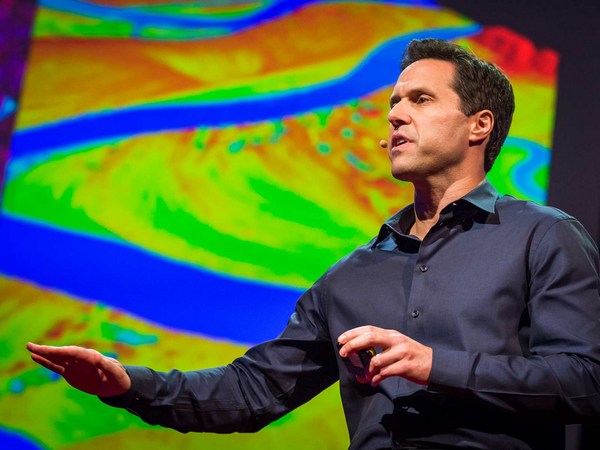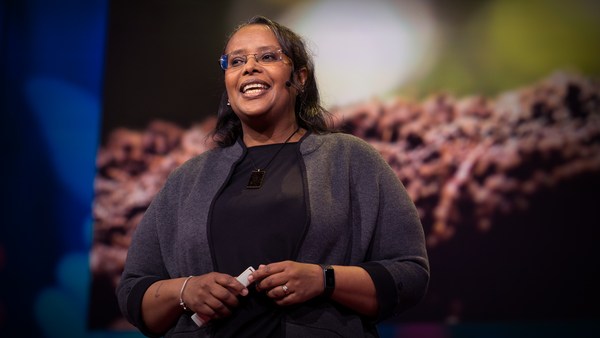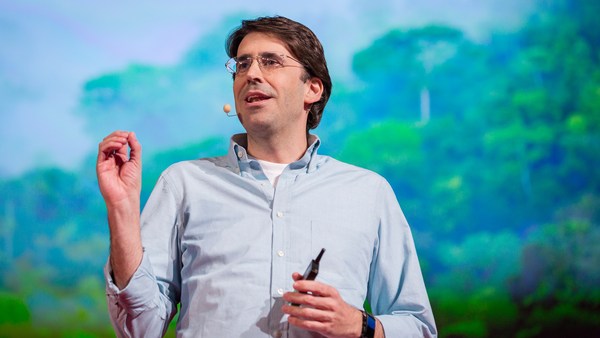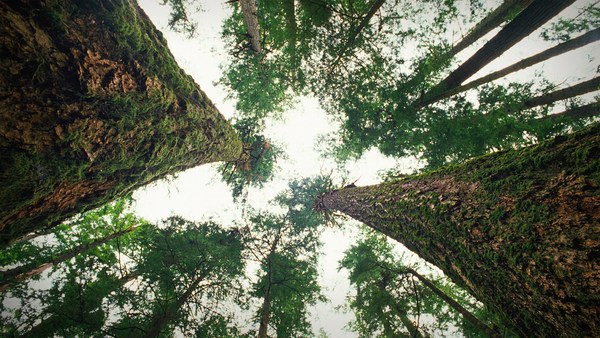Life ... it's all about embracing the challenge. Everyday, our lab brings together some of the world's leading environmental scientists, bringing together all that brain power to desperately try to figure out how to get this ball round a group of people without using our hands. It's so good; you hold a ball and a frisbee, you throw the ball in the air, throw the frisbee to the next person who catches the frisbee and then the ball without ever touching their hands. This challenge, frisball, is unbelievably addictive for the very simple reason that it's really, really hard. The failures can be catastrophic. But when you get lost in that game and it just takes you, it's unbelievable how those failures just pale in comparison to the true glory of success. (Laughter) I always thought this obsession with games is why I struggled in the university. When I was kicked out of class at the end of my first year, I thought it was the end of my degree. 300 people, I had to walk out in front of. It was devastating, but the professor took me aside and asked me, "Why bother? Why bother with ecology if you're not even going to try?" To which I explained, "I've always been obsessed with biodiversity. How life arose on this planet remains the greatest mystery, let alone how it diversified across the globe. But I simply cannot keep up. It's really hard to stay motivated when you can't keep up, and on top of that, I'm dyslexic, and so I failed to keep up with the boring reading, and, instead, preferred to play games with my friends." And he gave me the simplest bit of advice ever. He just said, "If you truly enjoy it, why not make ecology your next game?" And I know it sounds so simple, but it had the most profound impact on me. He said, "You don't need to try harder, you certainly don't need to be smarter, but if you embrace the challenge, not only are you way more likely to succeed, but even if you don't, Who actually cares? - you've been having a good time, and that's the point of all this in the long run anyway." Now, that simple advice had the most profound impact on me, and eight years later, I'm still studying biodiversity, this time, at a global scale. And in fact, I'm studying one of the greatest threats facing biodiversity of all time in climate change, this depressing topic that every single person in this room knows plenty about, so don't worry, I won't bog you down with the depressing details. We all know how threatening it is to us and our future generations, but the real challenge is figuring out how that we can get engaged, how can we make tangible impact to slow the rate of this devastating threat. Because the atmosphere that we're trying to protect is incredibly thin and vulnerable - it's like analogous to the width of the rubber on a balloon. And every year, we emit 10 gigatons of carbon into that space. I know a gigaton is a weird number, but essentially, it's a billion tons of carbon. So 10 gigatons is like 27,000 Empire State Buildings. And some of it goes into the land, and some of it goes into the oceans, but a large chunk of it remains in the atmosphere, and it's building up year on, year out, to the extent that we've increased the burden by about 300 gigatons since the start of the Industrial Revolution. Now, I'm a scientist, so I love numbers, and I'm going to throw big nonsense numbers at you, but if I could get you to remember at least one number, it's that 300 gigatons because that - that's the scale of the problem we need to address. So of course, we urgently need technological solutions to stop those 10 gigatons every year. We need to prevent emissions, but if we want to capture the 300 gigatons that already exist, we're going to need an immensely powerful system, and the most powerful system we've got to date is this: the natural system. This is a beautiful NASA simulation of the carbon cycle, showing high concentrations of carbon dioxide, indicated by red, at the beginning of the year, but as we kick on into spring, and then summer, we'll see these concentrations fade, and that's caused by one really simple thing: it's just the emergence of leaves on the trees. This simple ecological process transforms the carbon cycle every year, and it's one of the several massive ecological fluxes that entirely balance one another out. Given the massive scale of this system, managing it effectively has to be one of our brightest options in the fight against climate change. But it's also the nonsense one, we've all heard it before, the happy-clappy solution, "Plant a tree, save the world," we've all heard it before, but it's clearly not worked, because otherwise we'd be fine. But the real reason is we've not been able to get engaged. Because it's not a tangible and scientific solution, for the very simple fact that we have no idea what's physically possible. Until we know what we can achieve, who's going to waste their time and energy restoring ecosystems if you don't know what the impact will be. If we look at the top climate change solutions - Project Drawdown is a brilliant organization listing them - at the top of the list, with the potential to save 24 gigatons, is effective refrigeration management. But if you look down the list for global ecosystem management, you won't even find it because ecosystems, we have no idea of their global potential. So they're broken up into smaller parts and listed far below the top solutions. Again, who of us is going to spend our valuable time and energy in this, unless we know what we can actually achieve. Well, the real challenge is that the Earth's massive. It's really difficult to get a handle on that global information. So we've used satellites very well for the last few decades, which have great global coverage, but they can't see below the canopy surface. So until recently, we thought there was about 400 billion trees on the planet. And that was the basis of the UN's billion tree campaign: to plant a billion trees to save the world. But we knew we needed a new generation of model, a model built from millions of locations where people have stood on the ground counting trees and estimating how big those trees are and also which species they are. And once you've got all that information, you've got insights into the forest's structure, and by pairing all those millions of data points together, using machine learning and artificial intelligence, we can now start to fill in the gaps, and see the patterns in tree density, and how they vary across gradients of temperature and moisture and soil characteristics to generate the first quantitative understanding of global tree density, revealing, quite simply, that there are over 3 trillion trees on our planet. Again, I realize it's hard to understand what a trillion is, but essentially, it's more than we previously thought, and that simple piece of information was enough to change the billion tree campaign into the trillion tree campaign. So now we're restoring a trillion trees, and it's having great impact. Because we know the size of those trees, we also know that they store about 450 gigatons of carbon. That's the basis we're working with. But these models don't just tell us where trees are now. By characterizing the environment that can support trees, they also help us to see where trees can exist on the planet, showing that there's room for vastly more than we currently have. But obviously, much of this land is currently covered by forests, and a large proportion of it, we need for urban land and agricultural land that we need to support a growing human population. But when we remove those lands, we are left with something incredible. These are the 0.9 billion hectares of degraded lands, places where trees could naturally exist, but they don't, even though we're not using them extensively. If we were to restore ecosystems across all of those lands, there would be an additional trillion trees in that area, and they would store a staggering 205 gigatons of carbon. Now again, there's a lot of uncertainty in that number - they could be slightly higher or lower - but the scale of this, when you compare it to the 300 gigatons I mentioned earlier, we can all see that there is a vastly and immensely powerful carbon drawdown solution in the world's forests. Obviously, it would take over a hundred years to accumulate all of that carbon, but as soon as those trees are in the ground, not only are they sucking up carbon, they're also producing clouds, and those clouds reflect a lot of the sun's energy away, cooling the planet with an immediate effect. So when we announced this information less than two months ago, something just clicked, and it went absolutely viral. There was not an international media organization that didn't cover this extensively. It was like the public finally just saw an option for us to get engaged, and it was followed by an unbelievable spike in funding for restoration projects. And we saw projects starting up all over the world, and these are just the few that our lab is directly connected to. We're aware of thousands of others that are emerging to restore ecosystems to capture carbon. But it also introduced us to some of the wonders of social media, which was a terrifying insight. We had an absolute insanity of messages, but when you sift through those messages, there are some really important and valuable themes. The first criticism, "This is so stupid. We can't just plant trees everywhere, we need emissions cuts." While I don't entirely love the introduction to it, this is absolutely correct. I can't argue with that. Of course, everybody must know that we need technological and system-level changes to prevent emissions. But that has to be done in combination with powerful carbon drawdown. Climate change is way too big for us to be squabbling over solutions - we need all of them right now. The second criticism, "No! We need to conserve existing forests." Once again, it's very hard to disagree because this is absolutely correct! Of course, increasing the global forest cover wouldn't make any sense if we just gained new forests at the expense of the old ones. Preserving those existing forests is central to our entire goal. Of course, it's absolutely critical, so they must be done in combination. And the third criticism - you can see a trend now - is we need to preserve and restore natural grasslands and savannas, and again, for fear of repeating myself, this is abundantly correct. These ecosystems are immensely important, and that was part of the reason for us doing the study in the first place, so that we could identify where trees should go and where they shouldn't. Because those ecosystems are really key as well. They store huge amounts of biodiversity, and their carbon is amazing too, but it's not stored in the vegetation. It's actually stored in the soil below our feet. So we've been building a new generation of models now. Instead of basing them on observations of trees, they're based on millions of soil samples, collected all across the globe. And again, using the same artificial intelligence and machine learning, we can start to see the patterns, revealing that there is over 1,500 gigatons of carbon in the soil below our feet, with the majority of it existing in the high latitude areas, where cold conditions trap up carbon in the soil. And the amazing thing is that if we restored those soils across the globe, we could capture another 116 gigatons of carbon. That's the second insanely powerful carbon drawdown solution that I've introduced to you, and that's just in the soil below our feet. And this expands across all ecosystems. Where forests are now, just conserving and preserving them could capture 30% of that. But grasslands and shrublands cover an even larger expanse, and they could capture a staggering 41% of that potential if we just restore them effectively. And the nice thing about them is that they don't come at the expense of any other land use type. So you could have your agriculture at the same time as preserving and capturing more and more carbon. And actually, the most efficient of all those ecosystems are the wetlands and peatlands which would cover less than 5% of the Earth's surface and could capture about 30% of that amount. So when all in combination, we can see that these ecosystems have an overwhelming potential to capture this 300 gigatons. This powerful carbon drawdown solution is not just immense, but it's also one that can engage every single one of us and must be done in combination with cuts to greenhouse gas emissions. But of course, they have to be done ecologically responsibly. Too many times, restoration projects fail because trees are restored in the wrong soils or in ecosystems without a microbial community that can support them. So we spend all of our time and energy generating maps, maps that can show land managers how to manage those ecosystems right, so they can zoom into their area of interest and say not only how many trees go there or which species of trees should go there, but you can even see what the soil microbial community is like, to see if they support trees. And you can even calculate where the forests would have a warming or a cooling impact in different parts of the globe to really understand the ecological consequences of those actions. And even more importantly than that is that these projects have to be socially responsible. Too many times, restoration projects come and they buy up an area of land, excluding people from that land. Now that land is those people's livelihoods. Not only is that socially irresponsible, but it's also unsustainable because those people will come back and cut down that forest and use it for their livelihoods subsequently. Restoration has to be done in combination with local communities, so all funding coming towards restoration projects can be funneled through that community, so they become connected to that project. On top of that, they can benefit from the thousands of ecosystem services like food and medicine, and clean air and water that bring huge socioeconomic benefits when done correctly. All of those projects, those little dots that I showed you earlier, are doing this, working in combination with the local communities to restore ecosystems around the world, and they're having incredible social and economic consequences. And the best of them are doing so for as little as thirty cents a tree. And so this means, if we were to restore our one trillion trees, if we were to maximize efficiency, we could do so for as little as 300 billion dollars. That is nothing compared to the trillions of dollars we spend every year as a result of climate change. So now we genuinely do have a climate solution that can engage every single one of us through simple and tangible actions that have a positive impact, either by restoring ecosystems yourselves, and you can look at the maps to see exactly where and how, or simply donate. Click on one these dots to donate to one of the incredible restoration projects that are doing unbelievable work on our behalf, or finally, just invest your money wisely. Whether you're spending it or investing it, focus on the organizations that have a positive environmental impact, and we can have tangible impact on climate change. There's 8 billion of us on this planet. That gives us an unprecedented power for global action, but until now, climate action has always been about giving up the things we love, and while those commitments are incredibly important for cutting greenhouse gas emissions, we now also have positive actions that we can take, which make us feel good, and get us involved in the fight. Which brings me to the final criticism, "This all sounds fine, but it's just naive. We'll never restore the entire globe." Now this criticism may also be correct, but it's also entirely irrelevant. Because this thinking doesn't help anything. Ultimately, this is just an excuse to do nothing, "If we can't achieve 100%, ah, let's not bother." This is the kind of thinking that got us in this place. If we achieve even 5% of our goals, the impacts for biodiversity and climate change would be incredible, and I can promise you, we're going to exceed those efforts with the thousands of people restoring ecosystems around the world. I just hope the people saying, "It can't be done" don't interrupt the incredible people that are already doing it. Overcoming this negative thinking, this depression around climate change, I think is one of our greatest remaining challenges to get us all engaged. And to do this, I draw on the words of that brilliant supervisor, Dr. Hefin Jones, who said, "Just embrace the challenge. Not only are we more likely to succeed, but we'll all literally be enjoying the process." We may be the first society facing the real threat of climate change, but that necessarily means we're the first society that has a chance to save the world against it. Thank you very much. (Applause)
Related talks

Greg Asner: Ecology from the air

Willie Smits: How to restore a rainforest

Asmeret Asefaw Berhe: A climate change solution that's right under our feet

Tasso Azevedo: Hopeful lessons from the battle to save rainforests

Suzanne Simard: How trees talk to each other
